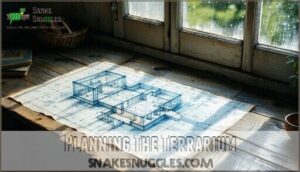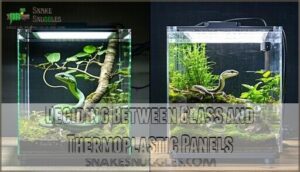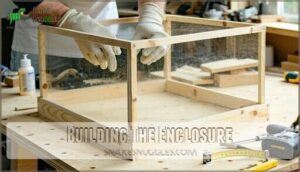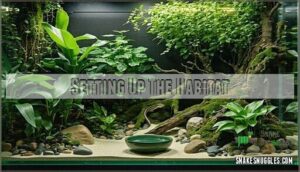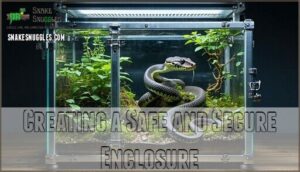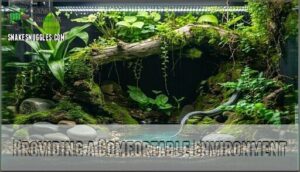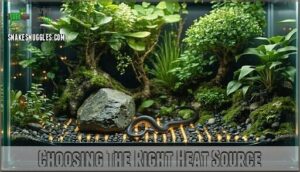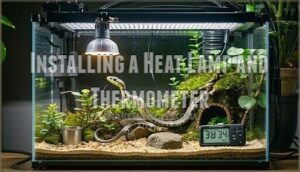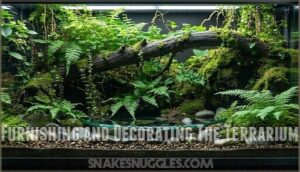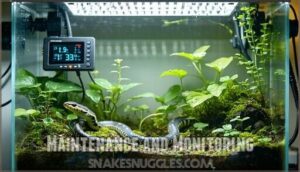This site is supported by our readers. We may earn a commission, at no cost to you, if you purchase through links.
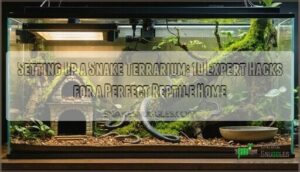
Start with a secure enclosure that prevents escapes. Add 2-3 inches of proper substrate like aspen or coconut fiber.
Create temperature zones (75-85°F warm side, 70-75°F cool side) using under-tank heaters or ceramic bulbs.
Include two hide boxes, one on each end, plus climbing branches for enrichment. Don’t forget a water dish large enough for soaking.
Like building a tiny apartment, every element serves a purpose. The right setup means fewer health issues and a snake that feels right at home.
Table Of Contents
- Key Takeaways
- Planning The Terrarium
- Choosing The Right Materials
- Building The Enclosure
- Setting Up The Habitat
- Designing a Snake-Friendly Environment
- Creating a Safe and Secure Enclosure
- Providing a Comfortable Environment
- Installing Heating and Lighting
- Furnishing and Decorating The Terrarium
- Maintenance and Monitoring
- Frequently Asked Questions (FAQs)
- How do you set up a snake terrarium?
- What is a snake terrarium?
- How do you keep a snake in a terrarium?
- How to choose a snake terrarium?
- How to set up a corn snake terrarium?
- How do you make a terrarium a happy snake?
- What is the Best Type of Terrarium for a Snake?
- How Often Should the Temperature and Humidity in a Snake Habitat Be Monitored?
- What Kind of Decorations and Accessories Should Be Included in a Snake Terrarium?
- What is the Best Way to Clean and Maintain a Snake Terrarium?
- Conclusion
Key Takeaways
- Plan your terrarium size based on your snake’s adult length, aiming for at least 1.5 times its length, and ensure proper ventilation and escape-proof features.
- Create a temperature gradient with a basking area (85-95°F) and a cooler zone (70-75°F), using heating elements like lamps or mats with thermostats for safety.
- Add enrichment with hides, climbing structures, and safe plants to mimic your snake’s natural habitat while providing spots for security and exploration.
- Maintain humidity levels based on your snake’s needs, monitor temperature and humidity daily, and clean the terrarium regularly with reptile-safe disinfectants.
Planning The Terrarium
You’ll need to map out your snake’s home before grabbing the first piece of wood, just like you wouldn’t build a house without blueprints.
Design your snake’s palace with care—every detail matters when transforming a simple box into a slithering paradise.
Your reptile buddy will thank you for thinking ahead about size, layout, and ventilation—the difference between a snake palace and a scaly prison cell.
Determining The Right Size
Measuring your snake terrarium correctly prevents future headaches.
Your reptile needs room to thrive:
- Match the enclosure length to at least your snake’s full adult size, allowing complete stretching
- Calculate space using the formula: one square foot per foot of snake length
- Consider activity levels when determining enclosure depth
- Plan ahead for growth, especially with juvenile snakes that will double or triple in size
Choosing The Ideal Layout
With your terrarium size settled, let’s map out your snake’s dream home. Smart layout design makes all the difference!
Start with a temperature gradient—warm basking area on one end (90°F) and cooler zone (70-75°F) on the other. This mimics natural conditions and lets your snake self-regulate.
| Feature | Placement | Purpose |
|---|---|---|
| Basking Area | One end, under heat lamp | Warmth and digestion |
| Hiding Spots | Several locations | Security and stress reduction |
| Water Dish | Easily accessible | Hydration and soaking |
Add climbing structures for species that enjoy height. Snake behavior should guide your enrichment features—some prefer ground cover while others love branches!
Considering Ventilation and Escape Prevention
Now that you’ve planned your layout, let’s tackle security and airflow. Your snake’s survival depends on proper ventilation, while your peace of mind requires escape prevention.
Mesh security isn’t just important—it’s non-negotiable. Here’s why:
- One escaped snake can lead to weeks of panicked searching
- Poor airflow can cause respiratory infections within days
- The right ventilation placement prevents dangerous humidity buildup
Always install sturdy latches and fine mesh panels that balance airflow design with escape risks.
Choosing The Right Materials
You’ll want to pick materials that keep your snake safe and happy, not just ones that look nice in your living room.
The right combination of sturdy wood for structure and proper glass or plastic panels won’t just prevent escapes (snakes are notorious little Houdinis), but will also maintain the perfect temperature and humidity your scaly friend needs to thrive.
This structure is important because it provides a safe environment for your snake, and the perfect temperature and humidity are crucial for its well-being.
Selecting Sturdy Wood for The Frame
Now that you’ve planned your layout, let’s talk wood selection. Your terrarium’s frame needs to be sturdy and snake-safe.
For a hardwood frame that’ll last for years:
- Select moisture-resistant woods like oak, maple, or birch that won’t warp when exposed to humidity
- Steer clear of toxic woods like cedar or pine that release harmful oils
- Consider PVC-coated plywood for budget-friendly durability
For specialized needs, you can also find treated lumber. Your snake will thank you for that solid foundation!
Deciding Between Glass and Thermoplastic Panels
When you’re weighing your options for snake enclosure materials, the choice between glass and thermoplastic panels boils down to your priorities.
| Feature | Glass Terrarium | Thermoplastic Terrarium |
|---|---|---|
| Durability | High scratch-resistance | Better impact resistance |
| Visibility | Crystal clear views | Good but may cloud over time |
| Weight | Heavier, less portable | Lightweight, easier to move |
| Cleaning | Simple maintenance | May retain odors |
| Cost | Generally pricier | More affordable long-term |
Analyzing Cost Differences and Durability
Now that you’re comparing glass and thermoplastic panels, let’s talk money and toughness.
Glass offers crystal-clear viewing but costs more upfront and can crack if bumped. Thermoplastic panels save you cash and resist breaking, perfect when kids are around.
Your material choice affects:
- Initial investment vs. long-term value
- Safety standards and repair costs over time
- Snake enclosure durability during cleaning and handling
"Buy nice or buy twice," snake keepers often say! Many keepers choose plastic due to its moisture resistance benefits.
Building The Enclosure
You’ll need sturdy materials and precise measurements to transform your snake’s housing dreams into reality.
With your tools ready and patience in hand, you’re about to create a secure home where your scaly friend can thrive without practicing its escape artist skills.
Enclosure Basics and Essential Supplies
The journey to snake homeownership begins with gathering essential supplies. Your terrarium setup requires thoughtful planning and the right materials.
| Essential Supply | Purpose | Budget Option |
|---|---|---|
| Enclosure | Security and containment | Plastic tub |
| Substrate | Burrowing and humidity | Aspen or coconut husk |
| Heating element | Temperature regulation | Heat mat with thermostat |
Remember, your snake enclosure size must accommodate your pet’s adult length – that 12-inch hatchling might reach 6 feet! Aim for a minimum 48L x 24W x 24H for corn snakes. Many retailers offer essential snake products for new reptile owners.
Don’t skimp on ventilation needs; proper airflow prevents respiratory issues. When selecting terrarium types, consider both your snake’s comfort and your maintenance capabilities.
Cutting and Installing Mesh Panels
Several mesh panel options exist for your snake’s terrarium, each offering different benefits for ventilation and security.
When cutting and installing mesh panels:
- Choose aluminum or stainless steel mesh to prevent rust and resist determined escape artists
- Cut panels 1/4 inch larger than the opening for secure fastening with overlap
- Apply silicone sealant around edges before screwing down frame pieces
Remember, proper ventilation balance is vital – too much airflow can affect humidity, while too little can create stagnant conditions. Double-check all fasteners to guarantee your snake can’t push through any weak spots.
Creating a Top or Side Opening
After securing your mesh panels, it’s time to decide on your terrarium’s access point.
Top openings offer superior snake enclosure security with excellent escape prevention, while side openings provide easier cleaning access and simpler heat lamp installation.
When planning your opening size, consider hinge placement and latch security carefully.
Your choice should balance your snake’s safety with your need for comfortable access during feeding and maintenance.
Setting Up The Habitat
You’ll need to transform your empty snake enclosure into a comfortable home with the right temperature zones, hiding spots, and moisture levels.
Your scaly friend won’t send you a thank-you card, but proper habitat setup directly affects their health and happiness.
Creating a Temperature Gradient
Every snake needs its own temperature zones to thrive. Creating the perfect gradient is essential for their health.
Creating the perfect temperature gradient is your snake’s secret to thriving—offering comfort, health, and a home they’ll love.
- Position your heat lamp on one end of the terrarium, keeping the opposite side naturally cooler
- Install a quality thermostat to maintain 90°F on the warm side and 75-80°F on the cool side
- Use digital thermometers at both ends for accurate monitoring
This setup lets your snake choose exactly where it’s comfortable throughout the day. A proper gradient also supports vital thermoregulation needs.
Providing Hiding Spots and Basking Areas
With your temperature gradient set up, let’s make your snake feel at home with the perfect relaxation spots.
Snakes need both hiding spots for security and basking areas for warmth.
| Hide Type | Purpose | Best Placement |
|---|---|---|
| Cork Bark | Security | Both hot/cool sides |
| Rock Cave | Thermal retention | Hot side |
| Half Log | Easy monitoring | Cool side |
| PVC Pipe | Budget-friendly | Either side |
Position secure hides at opposite ends for temperature choices.
Your thermometer should show 88-92°F at the basking spot, with cooler shade options nearby.
Maintaining Humidity Levels
Inside your snake’s terrarium, humidity control acts like the weather forecast – get it right, and you’ll have a happy reptile.
Your hygrometer readings should match your snake’s natural habitat.
- Choose humidity-retaining substrates like coconut husk for tropical species
- Set up a misting schedule based on your snake’s shedding cycle
- Place your water dish on the warm side for natural evaporation
- Balance ventilation to maintain moisture without creating stagnant air
Designing a Snake-Friendly Environment
You’ll transform your snake’s enclosure from a basic box to a reptile paradise by creating natural features that encourage normal behaviors.
Just like you wouldn’t want to live in an empty apartment, your scaly friend needs hiding spots, climbing branches, and strategic plant placement to feel secure and thrive in captivity.
Creating Cozy Hides and Burrows
Creating two perfectly sized hides is essential for your snake’s security.
Place one hide at each end of the temperature gradient using safe materials like cork bark, ceramic, or stone.
For burrowing species, add 2-3 inches of substrate depth for natural burrow design.
Rock placement should create small den boxes while avoiding collapse risks.
You’ll make your reptile feel right at home with these considerations, ensuring a comfortable environment that meets their needs, including a suitable temperature gradient.
Adding Climbing Structures for Natural Behavior
Building on your cozy hideouts, let’s transform your terrarium into a vertical playground! Strategically place climbing structures to encourage natural snake behavior and provide essential arboreal enrichment.
Strong branches, cork bark, or PVC pipes work wonders – just make certain they’re secured to prevent accidents. Different textures and heights will keep your reptile mentally stimulated.
For tree-dwelling species, vertical space isn’t optional – it’s essential for their well-being. Your snake will thank you by displaying its natural climbing abilities, showcasing its ability to thrive in a well-designed arboreal environment with essential enrichment.
Using Plants for Camouflage and Aesthetics
Plant power can transform your snake’s home from bland to grand.
Thoughtfully selected greenery creates natural camouflage while enhancing your terrarium’s visual appeal.
When choosing snake terrarium plants, consider:
- Plant toxicity – stick to snake-safe options like pothos or bromeliads
- Maintenance needs – artificial plants require less upkeep than live ones
- Lighting requirements – match plant needs with your existing setup
Mix artificial and live plants to balance aesthetic appeal with practical care.
Your slithery friend will appreciate the hiding spots, and you’ll enjoy the natural terrarium decor.
Remember, plants aren’t just decorations—they’re functional elements that help your snake feel secure in its environment, and provide a sense of natural surroundings, making them a great way to create a grand terrarium.
Creating a Safe and Secure Enclosure
You’ll need to prevent your slithery friend from pulling a Houdini by creating an escape-proof home with the right glass thickness, secure adhesives, and quality latches.
Think of your enclosure as a mini Fort Knox – strong enough to keep your snake safely inside while keeping curious pets and little fingers safely outside.
Choosing The Right Glass Panel Thickness
After designing your snake’s living space, you’ll need to choose the right glass thickness for safety and durability.
You wouldn’t use paper for an aquarium, right? Same logic applies here!
| Glass Thickness | Snake Size | Advantages | Considerations |
|---|---|---|---|
| 1/8" (3mm) | Small species | Budget-friendly, lightweight | Lower impact resistance |
| 3/16" (5mm) | Medium species | Good balance of strength/cost | Standard for most enclosures |
| 1/4" (6mm) | Large/strong species | Superior strength, escape-proof | Heavier, more expensive |
| 3/8"+ (10mm+) | Giant constrictors | Maximum security | Requires special framing |
Securing The Glass Panel With Adhesive
Now that you’ve selected the perfect glass thickness, it’s time to lock it in place.
Silicone aquarium sealant is your best adhesive choice for securing glass panels—it’s waterproof and non-toxic after curing. Run a continuous bead along frame edges, pressing firmly to eliminate gaps.
Remember safety precautions: work in a well-ventilated area and wear gloves. For thermoplastic panels, use a specialized plastic adhesive instead.
Allow 24-48 hours for complete curing time before adding your snake. Proper application techniques guarantee long-term durability and escape prevention for your secure enclosure.
Using Sturdy Hinges and Latches
Now that your glass panel is firmly in place, it’s time to focus on the gatekeepers of your snake’s home. Quality hinges and latches aren’t just accessories—they’re your first line of defense against escape artists.
Here are 5 must-know facts about securing your terrarium:
- Choose marine-grade stainless steel hinges for long-term durability
- Install double-locking latches for extra escape prevention
- Test all fastening mechanisms before introducing your snake
- Position hinges every 8-10 inches for larger enclosures
- Select child-safe secure latches if you have little ones at home
The provided list offers a comprehensive guide to ensuring your terrarium is secure, with a focus on long-term durability and escape prevention.
Providing a Comfortable Environment
You’ll transform your snake’s terrarium from a basic box into a cozy reptile retreat by adding the right substrate, plants, and water features.
Just like you wouldn’t want to sleep on a bare floor with nothing to drink, your scaly friend needs proper bedding, hiding spots, and fresh water to truly feel at home, with complete concepts of comfort and care.
Substrate Selection
Five essential factors determine your perfect snake substrate: safety, natural mimicry, maintenance, humidity control, and cost-effectiveness.
Substrate Type
Burrowing-friendly, absorbent
humidity retention
Easy to clean, reusable
Quarantine substrates
Always prioritize substrates that minimize impaction risk if swallowed.
For bioactive setups, mix coconut fiber with topsoil (3" deep) to support natural burrowing behavior while maintaining proper terrarium substrate moisture levels.
Selecting the right snake bedding options is essential for reptile health.
Your snake’s comfort depends on your substrate choice!
Providing Vegetation and Cover
After setting up your substrate base, it’s time to add some greenery and cover to your snake’s home.
Vegetation offers more than just looks—it provides visual security your reptile needs to feel safe.
Here are five options to create the perfect hideaway:
- Live snake-safe plants like pothos or spider plants (great for bioactive terrariums)
- Artificial cover that won’t rot or mold
- Cork bark rounds or flats for natural hiding spots
- Fake vine decorations for climbing structures
- Moss piles that double as humidity boosters
Mix and match hiding variety throughout the enclosure. Your snake will thank you with natural, relaxed behaviors!
Adding a Water Dish
Beyond plants, your snake needs a proper watering hole. Choose a water dish that’s large enough for occasional soaking but not deep enough to pose drowning risks.
Position it on the cool side of your terrarium to prevent rapid evaporation.
| Dish Material | Pros | Cons |
|---|---|---|
| Ceramic | Sturdy, heavy | Breakable |
| Plastic | Lightweight, cheap | Can tip easily |
| Stone | Natural look, stable | Heavy to clean |
| Metal | Durable | Conducts heat/cold |
Clean daily to prevent bacteria growth. Your slithery friend will thank you for a clean and proper environment!
Installing Heating and Lighting
You’ll need to set up proper heating and lighting to keep your scaly friend happy, just like how you wouldn’t want to live in a cold, dark house.
Creating the right temperature gradient with heat lamps or mats will guarantee your snake can regulate its body temperature naturally, while proper lighting helps maintain their day-night cycles, ensuring a healthy environment for your pet, with the right lighting.
Choosing The Right Heat Source
Every reptile owner needs a reliable heat source to keep their snake comfortable and healthy.
When selecting your heating option, consider:
- Ceramic heat emitters – Provide infrared radiation without light, perfect for 24/7 heating
- Under-tank heat mats – Deliver belly heat that terrestrial snakes love (always use with a thermostat!)
- Basking bulb options – Create a natural temperature gradient with directed heat
- Radiant heat panels – Offer even, efficient heating for larger enclosures
Remember, heat lamp safety prevents burns while proper thermometer placement guarantees your slithery friend stays cozy.
For consistent heating without light, consider ceramic heat emitters.
Installing a Heat Lamp and Thermometer
Now that you’ve chosen your heat source, it’s time to properly install your heat lamp and thermometer to create that perfect temperature gradient for your scaly friend.
Mount your lamp securely above the basking spot, ensuring it can’t fall into the enclosure. Place your thermometer on the opposite side to monitor the full temperature range.
| Heat Source | Placement | Distance | Benefits |
|---|---|---|---|
| Ceramic Lamp | Tank corner | 10-12" | No light disruption |
| Infrared Option | Center top | 8-10" | Nighttime heating |
| Halogen Bulb | Basking area | 12-15" | Natural sunlight feel |
| Heat Panel | Side wall | 6-8" | Even heat distribution |
Don’t forget to calibrate your thermostat before use—it’s like giving your snake its own personal climate control system! This step is crucial for ensuring the well-being of your pet.
Remember, the goal is to provide a comfortable environment with an appropriate temperature range for your snake, and proper installation and calibration are key to achieving this.
Setting Up Lighting Cycles and Duration
Now that your heat lamp is installed, let’s sync your snake’s day and night rhythm with proper lighting.
Create a consistent lighting schedule using these simple steps:
- Install a reliable timer to maintain 10-14 hour light cycles, mimicking natural diurnal cycles
- Consider UVB importance for daytime activity (though most snakes don’t require it)
- Adjust seasonal changes in duration to match your snake’s natural habitat
- Use spectrum effects from full-spectrum bulbs for better color perception
Snake enclosure lighting isn’t just about visibility—it’s about biological rhythm!
The goal is to provide an environment that supports the snake’s natural behaviors and physiological needs, and consistent lighting is crucial for this.
Furnishing and Decorating The Terrarium
You’ll transform your snake’s terrarium from a basic box into a five-star reptile resort with the right furnishings and decorations.
Adding natural elements like branches, rocks, and plants won’t just make the habitat look great—it’ll also create essential temperature zones and hiding spots that keep your scaly friend happy and healthy.
This will make your snake’s terrarium a wonderful place to live, with the natural elements creating a great environment.
Creating Visual Barriers
With your heating system in place, let’s help your snake feel right at home with some privacy screens.
Visual barriers aren’t just decorative—they’re essential for your snake’s mental health, reducing stress by creating defined territories within the enclosure.
Here are 4 ways to create effective visual barriers:
- Position cork bark slabs vertically as natural room dividers
- Cluster artificial plants densely to form secluded hiding areas
- Arrange hollow logs strategically to create protected pathways
- Stack terrarium-safe rocks to build mini rock formations with gaps
These simple additions transform your snake’s home from a fishbowl into a secure, stress-free sanctuary with multiple hiding spots, providing your snake with a sense of security.
Creating Temperature Gradients
Moving beyond visual barriers, your snake needs temperature choices just like we do.
Create a proper temperature gradient by placing your heat source at one end of the terrarium. You’ll want a warm basking spot (85-95°F) gradually cooling to the opposite end (70-75°F).
Use a reliable thermometer at both ends and calibrate your thermostat carefully. For ball pythons, maintaining a proper gradient is essential for supporting proper digestion.
Different snake species have unique temperature needs, so regular gradient monitoring is essential.
Adding Decorations and Accessories
With your temperature zones set up, it’s time to decorate your snake’s home with some reptile-friendly flair.
Your pet deserves enrichment variety that mimics its natural habitat:
- Climbing branches and cork bark for exploring (smooth edges prevent scale damage)
- Safe decor like fake plants for hiding spots (no sharp parts!)
- Burrowing options using leaf litter or hollow logs (snakes love to hide!)
These accessories aren’t just pretty—they provide essential enrichment that keeps your slithery friend active and happy. They offer a way to create a natural habitat.
Maintenance and Monitoring
You’ll need to check your snake’s home just like you’d check the oil in your car—regularly and with attention to detail.
Keeping an eye on temperature, humidity, and cleanliness isn’t just good housekeeping, it’s the difference between a thriving snake and an unhappy roommate who might give you the cold shoulder at feeding time.
This task requires careful attention to the snake’s environment to ensure its well-being, making regularly checking its home crucial for a happy and healthy pet.
Regular Cleaning Schedules
After giving your terrarium that perfect decorative touch, you’ll need a solid cleaning plan to keep it healthy.
Your snake depends on you for waste removal and a germ-free home. For ideal health, maintain proper humidity.
Follow this simple cleaning schedule:
| Task | Daily | Weekly | Monthly | Quarterly |
|---|---|---|---|---|
| Spot Cleaning | ✓ | – | – | – |
| Water Changes | – | ✓ | – | – |
| Disinfecting | – | – | ✓ | – |
| Substrate Replacement | – | – | – | ✓ |
Use reptile-safe disinfectant for best results, and remember to prioritize your snake’s health through regular maintenance and a clean environment.
Temperature and Humidity Monitoring
Regular monitoring is the heartbeat of successful snake keeping.
Your thermometer and hygrometer aren’t just gadgets—they’re lifelines for your scaly friend.
- Sensor Placement: Position devices away from heat sources for accurate readings
- Species Requirements: Research your snake’s specific temperature and humidity needs
- Temperature Gradient: Maintain proper hot (85-95°F) and cool (75-80°F) zones
- Remote Monitoring: Consider digital systems that alert you to dangerous fluctuations
Check readings twice daily, adjusting as needed to prevent stress or health issues.
Handling and Observation Precautions
After securing your enclosure, always practice safe handling to minimize stress for your snake.
Watch for warning signs like hiding, refusing food, or defensive postures.
| Behavior | What It Means | Your Action |
|---|---|---|
| Rapid breathing | Stress | Give space |
| Coiling tightly | Fear | Back off |
| Tongue flicking | Curiosity | Proceed gently |
| Hissing/striking | Threat display | Return to enclosure |
Remember, quarantine protocols for new snakes aren’t just suggestions—they’re essential for preventing disease spread. It’s crucial to follow these guidelines to ensure the health and well-being of your snake, and practice these habits consistently.
Frequently Asked Questions (FAQs)
How do you set up a snake terrarium?
Choose the right-sized enclosure based on your snake’s adult length.
Add proper substrate, two hides, a water dish, heating elements, and secure a temperature gradient.
Don’t forget to snake-proof that lid!
What is a snake terrarium?
Roughly 4 million reptiles live as pets in U.S. homes.
A snake terrarium is your pet’s complete habitat – it’s a specialized enclosure where you’ll create a mini-ecosystem with proper temperature, humidity and enrichment for your slithery friend.
How do you keep a snake in a terrarium?
You’ll need to maintain proper temperature gradients, provide hiding spots, use appropriate substrate, guarantee secure enclosure with good ventilation.
Offer fresh water, and create enrichment opportunities for your snake’s health and happiness, including ensuring a secure environment that promotes overall wellness.
How to choose a snake terrarium?
You’ll want a terrarium that’s at least twice your snake’s length.
Consider glass for visibility, PVC for humidity control, and make sure it has secure locks.
Don’t forget proper ventilation too!
How to set up a corn snake terrarium?
Just as architects design homes for humans, you’ll create a perfect space for your corn snake.
Set up a 20-gallon tank with aspen bedding, two hides, climbing branches, water dish, and proper heating.
How do you make a terrarium a happy snake?
Keep your snake happy by offering a safe, secure enclosure with proper heating, humidity, and hiding spots.
Add climbing branches, enrich the habitat with textures, and monitor its environment.
Bonus: They love feeling like escape artists!
What is the Best Type of Terrarium for a Snake?
Finding the perfect terrarium is like choosing your snake’s dream home.
Glass works great for visibility and easy cleaning, while PVC retains humidity well.
Just make certain it’s escape-proof, ventilated, and spacious enough for comfort.
How Often Should the Temperature and Humidity in a Snake Habitat Be Monitored?
Check the temperature and humidity twice daily—once in the morning and again at night.
It’s like hosting the perfect reptile spa day!
Stable conditions prevent stress, illness, and those sneaky mood swings.
What Kind of Decorations and Accessories Should Be Included in a Snake Terrarium?
Imagine a blank space transforming into a snake haven.
Add hides for comfort, climbing branches for fun, and safe plants for ambiance.
Include a water bowl, thermal gradient tools, and textured decor for enrichment.
What is the Best Way to Clean and Maintain a Snake Terrarium?
Clean the terrarium weekly by removing waste, old substrate, and uneaten food.
Wipe surfaces with a reptile-safe disinfectant. Rinse thoroughly, verify dryness, and replace materials.
Spot-clean daily to prevent odors and bacteria buildup, ensuring a clean environment.
Conclusion
Think of setting up a snake terrarium like designing a cozy studio apartment—it’s all about thoughtful choices.
By picking the right size, creating temperature zones, and adding hides and climbing spots, you’re crafting a safe, inviting space for your snake to thrive.
Don’t forget to monitor humidity and keep the enclosure secure.
A well-planned terrarium means a healthier, happier reptile and fewer worries for you.
Happy snake-keeping, and enjoy your slithery roommate!
- https://www.boxofficemojo.com/chart/top_opening_weekend/
- https://talis-us.com/blogs/news/10-best-heat-sources-for-reptile-tanks?srsltid=AfmBOoqbfy9Njslz9zCmNGqayXCnx3TlNroaReHj44MmIyNPA_Q55Kg-
- https://community.morphmarket.com/t/heat-source-for-ball-python/42499
- https://familysnake.com/guides/mastering-the-art-of-temperature-control-in-your-snakes-habitat/
- https://www.instructables.com/Reptile-tank-heating-and-lighting-guide/

